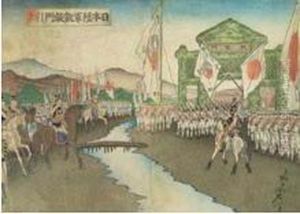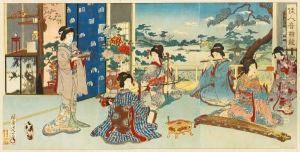Yosai Nobukazu Paintings
Yosai Nobukazu, born in 1872 and deceased in 1944, was a distinguished Japanese artist who played a significant role in the late Meiji period, a time of rapid modernization and westernization in Japan. Nobukazu was particularly known for his ukiyo-e woodblock prints, a genre of Japanese art that flourished during the 17th through 19th centuries, which he adeptly adapted to reflect the changing times of his era.
Nobukazu's work is characterized by vibrant colors and dynamic compositions, often depicting historical scenes, famous battles, and scenes from kabuki theater, as well as the more contemporary aspects of Japanese life in the Meiji period. He was adept at capturing the essence of both traditional Japanese culture and the new influences that were permeating society as Japan opened up to the West. His prints serve as a visual chronicle of this transformative period in Japanese history, offering insights into the social, cultural, and political shifts of the time.
Despite the prominence of his work during his lifetime, Nobukazu's legacy is sometimes overshadowed by that of his contemporaries and predecessors in the ukiyo-e tradition, such as Hiroshige and Hokusai. Nevertheless, his contributions to the genre and his ability to document a pivotal era in Japanese history through his art have earned him a respected place in the annals of Japanese art history. Nobukazu was part of the Watanabe School and worked alongside other artists who were also exploring the boundaries of traditional Japanese art by incorporating Western techniques and perspectives.
After his death in 1944, towards the end of World War II, Nobukazu's works continued to gain recognition for their historical value and artistic merit. Today, they are appreciated not only for their aesthetic qualities but also for their documentary value, offering a window into the Meiji period's complex interplay of tradition and modernity. Nobukazu's prints, with their vivid depictions and meticulous detail, remain a testament to the enduring appeal of ukiyo-e and its ability to evolve and resonate even as the world changes around it.

